Village
School
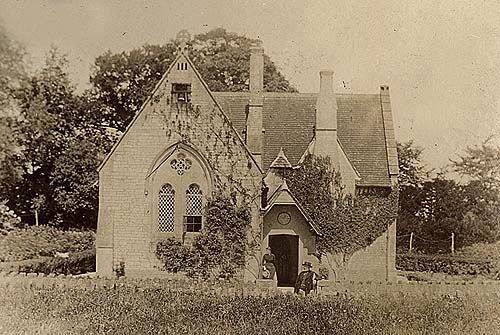
School
in 1890
In 1828 Mr. Spencer gave the number of Children as being 140 Boys and Girls, and of these 110 belonged to Hinton Parish, while 30 came from Freshf'ord and other parts immediately adjoining Hinton. Those from outside the Parish paid td. a week more than Hinton Children.
In 1833 the School Master was William Gane, the school Mistress Sarah Gane. The number of children: Boys 47. Girls 48. Annual subscribers provided £16. 17. 6. Among the subscribers in Hinton Parish were Mrs. Day, Mrs. Symonds (of the Priory) Mr. Samuel Bailey, the Rev. T. Spencer, Mr. J. Fisher of Broadfield, Mr. T. Bailey and Mrs. Frapwell.
The master and mistress received these subscriptions together with a penny per week from each child. Those children sent by subscribers were exempt from payment. Each subscriber having the privilege of sending one child free of expense for every 10/- of subscription. According to the report of 1833, in addition to the usual employments of reading, needlework, etc., about 24 'of the children had been taught to knit stockings, and any persons who were inclined to provide worsted could have excellent stockings made at the following prices:- men's stockings 9d. a pair; women's 7d., half the price being paid to the mistress and half to the knitters.
The following extracts from a letter written by the Rev. T. Spencer to Mrs. Day of Hinton House may be of interest. "The school is now brought into order, and presents a sight which must be highly gratifying to all who have the welfare of the inhabitants at heart, and to myself affords a pleasure far beyond anything I could have anticipated. As you have been the greatest individual benefactor to the school I feel assured you will not regret anything you have done for them if you will but witness their orderly conduct and interesting appearance, as well as the progress they make in useful learning."
The Rev. T. Spencer left in 1847, claiming £1,000 for money expended on Parsonage House, garden, glebe and one cottage; history does not relate if he ever got it. In 1848 four ruinous cottages were removed and a malt- house (formerly poor house) purchased from Mr. Willis by the Rev. C. Palairet of Norton Mr. Palairet also bought a cottage, now called Church Cottage.The Malt House was altered for use as a girls school.
In 1849 Mrs.Kemp of Doncaster is recorded as being school mistress of the Boys school in Wellow Road.
In 1851 Mrs. Kemp lef't f'or Canada. In 1854 the cottages adjoining Church Cottage were bought f'rom H. Brooke Esq, (of the Abbey) and taken down. 1856 The new cottage (school house) was built. Mrs. Kearney was Teacher. In 1860 the Malt House was removed and the school was built by Edward Jones, afterwards Foxcroft. W. White was the architect. The old Malt house had been bought in 1848 by the Rev. C. Palairet and conveyed to E. T. D. Jones in 1858.
Head Teachers -Hinton School
1871 ~ 1872 June 21sto Mr. Henry E. Kearney.
July 15th -August 9th, 1872 Miss Emily Williams.
Sept. 6th, 1872 -octo 20th, 1874 rvliss Mary Irvin.
Oct. 20th, 1874- Jan. 4th, 1883 Miss Ellen Callaway (Mrs. Toghill from 1882).
Jan. 8th, 1883- Oct. 30th, 1885 Miss Ellen Wescombe.
Nov. 3rd, 1885- Oct. 14th, 1886 Miss Annie Eo Morgan.
Oct. 18th, 1885 -Jano 7th, 1926 Miss Lucy R. White (1911 Mrs. R. Colborne).
March 2nd,1925 -Oct. 27th, 1926 Mrso Hilda Winif'red Dunning.
Nov. 1st, 1926- Nov. 14th, 1930 Miss Mary Ella Witcomb.
March 2nd, 1931 -Septo 30th, 1935 Miss Laura E. Light.
Oct. 1st, 1935- June 17th, 1938 Miss D. D. Dainton.
Sept. 1st, 1938- Octo 2nd, 1940 Miss A. M. Stockall.
Feb. 24th, 1941 -Sept. 27th, 1952 Mrs. J. E. A. Woodward.
Apr. 20th, 1953 -Miss W.K. Kempster
From
its beginning until January, 1931, the school took in children who remained there
until they reached the, for long, normal school leaving age of 13, but af'ter
January 1931, all children on reaching the "11 +" stage were moved either
to Frome Grammar School or to Combe Down School. The Hinton School then became
a Junior School and in October, 1932, there were as f'ew as 17 children on the
books. At the time of writing these notes, numbers are over 30 which means that
the School is entitled to have more than one teacher. In 1953, under the Education
Act of 1944, the School became a Junior Voluntary Aided School. It is not easy
to discover how much was paid in fees at diff'erent dates in the School's existence.
In the 1870's and 80's the ordinary f'ee seems to have been 2d. ~ week though
infants only paid 1/2d. Children designated as "Tradesmen's Children"
seem to have paid 6d. a week. Not unnaturally there was argument from time to
time as to what c onstituted a "Tradesman`s Chi ld " ; On September
4th, 1891, schools were declared free -no more fees being payable by parents.
The greatest number of children to be on the books was 112 (September 3rd, 1895).
The walls of the old School must have positively bulged, and how Miss Lucy R.
White, even when aided by monitress and pupil teacher, managed to teach so many,
seems little short of a miracle. However, Mr. Arthur Swift records that from personal
experience, Miss White was a grand woman for "walloping" the children,
so maybe she imparted knowledge effectively, if in a way of which most modern
educational psychologists would strongly disapprove: The old School Log Book records
much of local interest. The atmosphere of the Seventies, Eightees and Ninetees
was in some senses much more peaceful and happy-go-lucky. The internal combustion
engine did not exist, and those living in the country had to rely much more on
their own immediate resources for amusement. There is a greater air of independence
of a Central Authority -No Whitehall to worry. It is possible with a little imagination
to read so much into some of the rather brief and laconic entries in the Log Book.
Here are a few.
Feb. 2nd, 1882. Mrs. We refused to pay 2d. fee for daughter
Alice. Not at school.
March 6th, 1882. Alice & Charles returned. (Fee paid?).
June 11th, 1884. Admitted Arthur Swift to the Infant's Room. (A hero still
with us).
July 25th, 1884 Herbert Walter not as ready with his answers as he
might be. (Probably both teacher and taught suffering from the heat. Did he get
a walloping"?).
Aug. 4th,1884. School closed for Club Fete
Aug. 5th,1884.
Children very tired and dull. There is only one recording in the Log Book or any
wordy battle between teacher and parent.
Jan. 1 st, 1885. Headmistress insulted
by E.W. , Mother of Winifred
Absence for various kinds of work seems to have
been not unusual. One infers from the tone of the entries that it was without
permission of authority
June 29th, 1885 Frank Northover absent all day driving
horses for Mr. Clark.
Sept.14th, 1885. George Andrews absent all day working
for Mrs. Bailey.
Mar. 3rd, 1887. George Swift absent for a week for bird keeping.
Holidays, varying in length from a day to a week, were given to celebrate
Coronations, Royal Marriages, and the ends of Wars. Finally, partly because it
might be rash to note events too near the present day, let us end with a charming,
if slightly cryptic little extract from a report dated April 20th, 1896. The infants
are in nice order".
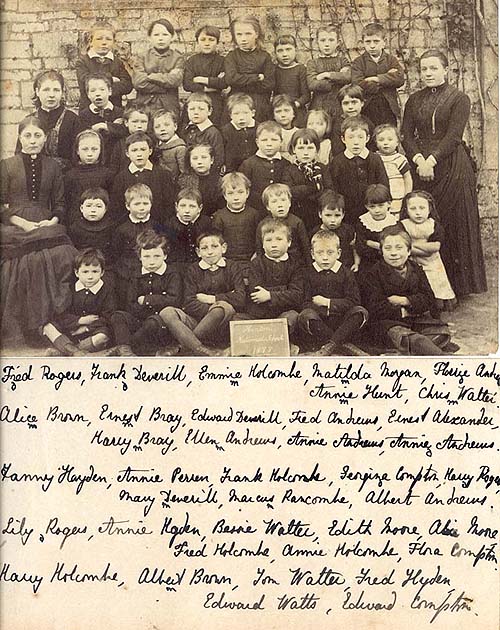
School
in 1888
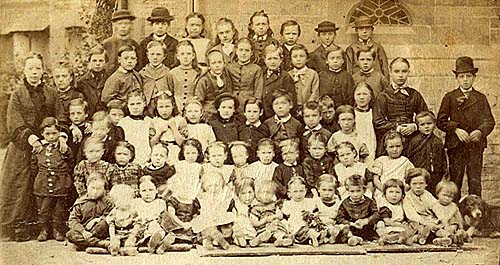
School
in 1876
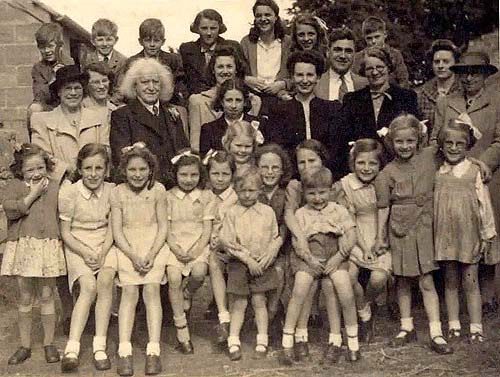
School
in 1943
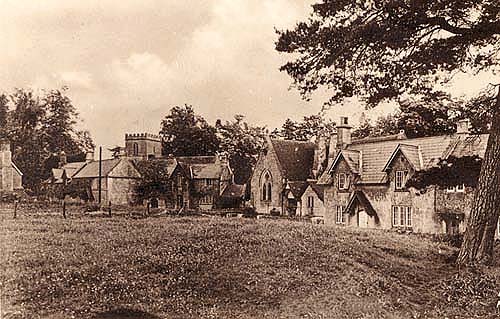
School
in 1930
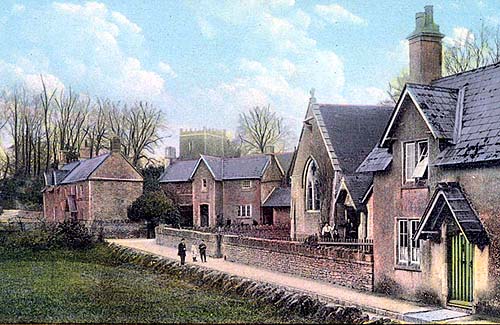
School
in 1910